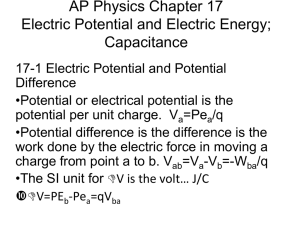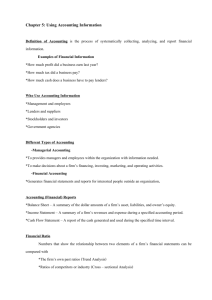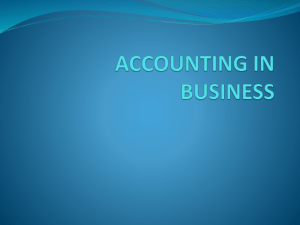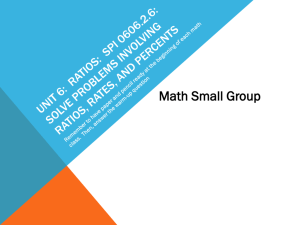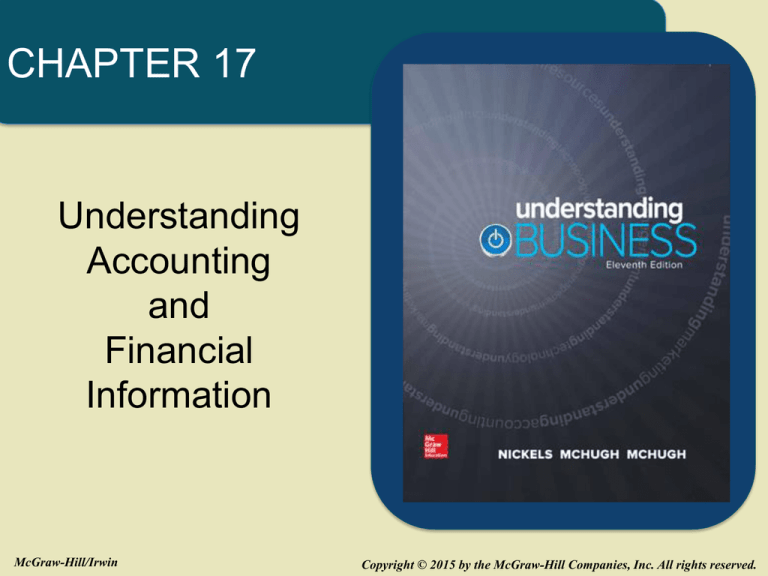
CHAPTER 17
Understanding
Accounting
and
Financial
Information
McGraw-Hill/Irwin
Copyright © 2015 by the McGraw-Hill Companies, Inc. All rights reserved.
LEARNING OBJECTIVES
1. Demonstrate the role that accounting and financial
information play for a business and its stakeholders.
2. Identify the different disciplines within the accounting
profession.
3. List the steps in the accounting cycle, distinguish
between accounting and bookkeeping, and explain
how computers are used in accounting.
17-2
LEARNING OBJECTIVES
4. Explain how the major financial statements differ.
5. Demonstrate the application of ratio analysis in
reporting financial information.
17-3
JOHN RAFTERY
Patriot Contractors
• Served in the Marines and
used his G.I. Bill to study
accounting.
• Completed an
entrepreneurship program
for veterans and launched
Patriot Contractors.
• He credits his knowledge of
accounting with the growth
of his business.
17-4
NAME that COMPANY
Accounting software makes financial information
available whenever the organization needs it.
We specialize in software that addresses the
accounting needs of small businesses that are
often very different from major corporations.
Name that company!
17-5
WHAT’S ACCOUNTING?
LO 17-1
• Accounting -- Recording, classifying, summarizing
and interpreting of financial events and transactions in
an organization to provide interested parties needed
financial information.
• Outside parties - like employees, owners,
creditors, unions, investors and the government make use of a firm’s accounting information.
17-6
The ACCOUNTING SYSTEM
LO 17-1
17-7
ACCOUNTANTS’
RESPONSIBILITIES
LO 17-1
17-8
MANAGERIAL ACCOUNTING
LO 17-2
• Managerial Accounting -- Provides information
and analysis to managers inside the organization to
assist them in decision making.
• Managerial accounting is involved with:
- Costs of production
- Costs of marketing
- Preparation and control of budgets
- Minimizing tax liabilities
17-9
USERS of ACCOUNTING
INFORMATION
LO 17-2
17-10
FINANCIAL ACCOUNTING
LO 17-2
• Financial Accounting -- Financial information and
analyses are generated for people primarily outside
the organization. Outside users are interested in
these questions:
- Is the organization profitable?
- Is it able to pay its bills?
- How much debt does it owe?
• Annual Report -- A yearly statement of the financial
condition, progress, and expectations of the firm.
17-11
HOW to READ
an ANNUAL REPORT
LO 17-2
• Key things to watch for and read:
- Management’s
discussion and
analysis of operations
- Balance sheet
- Income statement
- Statement of cash
flows
- Auditor’s opinion
17-12
PUBLIC vs. PRIVATE
ACCOUNTANTS
LO 17-2
• Private Accountants -- Work in a single firm,
government agency, or nonprofit organization.
• Public Accountants -- Provide accounting services
to individuals or businesses.
• Certified Public Accountants (CPAs) -Accountants who have passed a series of
examinations established by the American Institute of
Certified Public Accountants (AICPA) and met a states
requirements for education and experience.
17-13
WAYS to IMPROVE
ACCOUNTING PRACTICES
Source: www.soxlaw.com, accessed November 2014.
LO 17-2
17-14
DODD-FRANK ACT
LO 17-2
• Dodd-Frank Wall Street Reform and Consumer
Protection Act increased financial regulation by
increasing the power of the Public Company
Accounting Oversight Board.
• Act was brought on by the recent financial crisis.
Photo Credit: Nancy Pelosi
17-15
AUDITING CHECKS ACCURACY
LO 17-2
• Auditing -- Reviewing and evaluating the information
used to prepare a company’s financial statements.
• Independent Audit -- An evaluation and unbiased
opinion about the accuracy of a company’s financial
statements.
• Certified Internal Auditors (CIAs) -- Accountants
who have a bachelor’s degree and two years of
experience in internal auditing and pass an exam
administered by the Institute of Internal Auditors.
17-16
ELEMENTARY,
MR. AUDITOR, ELEMENTARY
• Fraud damages businesses, no matter the size.
• The SEC has committed itself to fighting fraud but not
all auditors and CPAs are trained in finding fraud.
• Colleges are offering advanced degrees in forensic
accounting to meet the upcoming demand for these
accountants.
17-17
SPECIALIZED ACCOUNTANTS
LO 17-2
• Tax Accountants -- Accountants trained in tax law
and are responsible for preparing tax returns or
developing tax strategies.
• Government and Not-forProfit Accounting -Support for organizations
whose purpose is not
generating a profit, but
serving others according to a
duly approved budget.
17-18
TEST PREP
• What’s the key difference between managerial
and financial accounting?
• How’s the job of a private accountant different
from that of a public accountant?
• What’s the job of an auditor? What’s an
independent audit?
17-19
The ACCOUNTING CYCLE
LO 17-3
• Accounting Cycle -- A six-step procedure that
results in the preparation and analysis of the major
financial statements.
17-20
BOOKKEEPER’S ROLE
LO 17-3
• Bookkeeping -- The recording of business
transactions. Bookkeepers divide a firm’s
transactions into meaningful categories and post
them into a record book or computer program called
a journal.
• Double-Entry Bookkeeping -- Bookkeepers
record all transactions in two places so they can
check one list of transactions against the other for
accuracy.
17-21
BOOKKEEPER’S TOOLS
LO 17-3
• Ledger -- A specialized
accounting book or
program where all
information is in one place.
• Trial Balance -- A
summary of all the
information in the account
ledgers.
17-22
TECHNOLOGY and ACCOUNTING
LO 17-3
• Computerized
accounting programs
post information
instantly and from
remote locations.
• Intuit’s QuickBooks
address the specific
needs of small
businesses.
17-23
TEST PREP
• How is the job of the bookkeeper different from
an accountant?
• What’s the purpose of accounting journals and a
ledger?
• Why does a bookkeeper prepare a trial balance?
• How has computer software helped businesses in
maintaining and compiling accounting
information?
17-24
FINANCIAL STATEMENTS
LO 17-3
• Financial Statement -- A summary of all the
financial transactions that have occurred over a
particular period.
• Key financial statements of
business are:
- Balance sheet
- Income statement
- Statement of cash flows
17-25
The FUNDAMENTAL
ACCOUNTING EQUATION
LO 17-4
• Fundamental Accounting Equation -- The basis
for the balance sheet.
• The equation must always be balanced and
includes the formula:
Assets = Liabilities + Owners Equity
17-26
The BALANCE SHEET
LO 17-4
• Balance Sheet -The financial
statement that
reports a firm’s
financial condition
at a specific time.
17-27
ASSETS
LO 17-4
• Assets -- Economic resources owned by a firm.
Items can be tangible or intangible.
• Liquidity -- Ease with which assets can be
converted into cash.
17-28
CLASSIFYING ASSETS
LO 17-4
• Current Assets -- Items that can or will be
converted to cash within one year.
• Fixed Assets -- Long-term assets that are relatively
permanent such as land, buildings, or equipment.
• Intangible Assets -- Long-term assets that have no
physical form but do have value such as patents,
trademarks, and goodwill.
17-29
CLASSIFYING LIABILITIES
LO 17-4
• Liabilities -- What the business owes to others - its
debts.
• Accounts Payable -- Current liabilities a firm owes
for merchandise or services purchased on credit.
• Notes Payable -- Short or long-term liabilities a
business promises to pay by a certain date.
• Bonds Payable -- Long-term liabilities that the firm
must pay back.
17-30
OWNERS’ EQUITY ACCOUNTS
LO 17-4
• Owners’ Equity -- The
amount of the business that
belongs to the owners minus
any liabilities of the owners.
• Retained Earnings -Accumulated earnings from the
firm’s profitable operations
that are reinvested in the
business.
17-31
TEST PREP
• What do we call the formula for the balance
sheet? What three accounts does it include?
• What does it mean to list assets according to
liquidity?
• What is the difference between long-term and
short-term liabilities on the balance sheet?
• What is owners’ equity and how is it determined?
17-32
The INCOME STATEMENT
LO 17-4
• Income Statement -- The
financial statement that
shows a firm’s bottom line that is, its profit after costs,
expenses, and taxes.
• Net Income/Net Loss -The revenue left over after
costs and expenses.
17-33
The INCOME STATEMENT
LO 17-4
• The formula for the income statement:
Revenue
-Cost of Goods Sold
= Gross Profit
-Operating Expenses
= Net Income before Taxes
-Taxes
= Net Income or Net Loss
17-34
ACCOUNTS of the INCOME
STATEMENT
LO 17-4
• Revenue is the monetary value a firm received for
goods sold, services rendered or other payments.
• Cost of Goods Sold (or Manufactured) -Measures the cost of merchandise the firm sells or
the cost of raw materials and supplies it used in
producing items for resale.
• Gross Profit (or Gross Margin) -- How much a
firm earned by buying (or making) and selling
merchandise.
17-35
THE IN’S and OUT’S of
VALUING INVENTORY
• Generally Accepted Accounting
Principles (GAAP) sometimes
permits accountants to use different
method of accounting for inventory.
• FIFO: First-In, First-Out
• LIFO: Last-In, First-Out
• Each valuation can affect income
and ending inventory valuation.
17-36
ACCOUNTS of the INCOME
STATEMENT
LO 17-4
• Operating Expenses – Cost
involved in operating a business,
such as rent, salaries and
supplies.
• Depreciation -- The systematic
write-off of the cost of a tangible
asset over its estimated useful
life.
17-37
The STATEMENT of CASH FLOWS
LO 17-4
• Statement of Cash Flows -- Reports cash
receipts and cash disbursements related to the three
major activities of a firm:
1. Operations
2. Investments
3. Financing
17-38
UNDERSTANDING CASH FLOW
LO 17-4
• Cash Flow -- The difference between cash coming
in and cash going out of a business.
• Managing cash flow is
a key consideration of a
business and can be
particularly challenging
for small and seasonal
businesses.
17-39
WOULD YOU COOK the BOOKS?
• You are the only accountant employed by a small,
struggling dog food company.
• The company requests a bank loan to keep
operations going and your boss suggests you
record some revenue early.
• This is against accounting principles, but you
know if you don’t get the loan, you may lose your
job. What do you do?
17-40
TEST PREP
• What are the key steps in preparing an income
statement?
• What’s the difference between revenue and
income on the income statement?
• Why is the statement of cash flows important in
evaluating a firm’s operations?
17-41
USING FINANCIAL RATIOS
LO 17-5
• Ratio Analysis -- The assessment of a firm’s
financial condition using calculations and financial
ratios developed from the firm’s financial statements.
• Key ratios include:
- Liquidity ratios
- Leverage ratios
- Performance ratios
- Activity ratios
17-42
COMMONLY USED
LIQUIDITY RATIOS
LO 17-5
• Liquidity ratios measure a firm’s ability to turn
assets into cash to pay its short-term debts.
• Two key ratios are:
- Current ratio
- Acid-test ratio
• This information is found on the firm’s balance
sheet.
17-43
LEVERAGE RATIOS
LO 17-5
• Leverage ratios measure the degree to which a
firm relies on borrowed funds in its operations.
• Key ratios include:
- Debt to Owner’s Equity Ratio
• This information is found on the firm’s balance
sheet.
17-44
PROFITABILITY RATIOS
LO 17-5
• Profitability ratios measure how effectively a
firm’s managers are using the firm’s various
resources to achieve profits.
• Key ratios include:
- Basic earnings per share
- Return on sales
- Return on equity
• This information is found on the firm’s balance
sheet and income statement.
17-45
ACTIVITY RATIOS
LO 17-5
• Activity ratios measure how effectively
management is turning over inventory.
• Key ratios include:
- Inventory turnover ratio
• This information is
found on the firm’s
balance sheet and
income statement.
17-46
SPEAKING a UNIVERSAL
ACCOUNTING LANGUAGE
• Multinational companies must adapt their
accounting reporting to the rules of multiple
countries.
• Many countries have adopted International
Financial Reporting Standards (IFRS) and are
pushing to make them standard.
• The U.S. Securities & Exchange Commission
believes there should be such a standard.
17-47
TIMELINE for the MOVE to IFRS
LO 17-5
• 2008: SEC offered proposed timeline
• 2009: 110 large companies had the option of using
IFRS
• 2012: SEC assessed progress of IFRS
• 2013: Final decision on the move to IFRS
• 2015: Large public companies will be required to
report in IFRS (pending SEC decision)
• 2016: All companies will be required to report in IFRS
(pending SEC decision)
Source: IFRS.org, accessed November 2014.
17-48
TEST PREP
• What’s the primary purpose of performing ratio
analysis using the firm’s financial statements?
• What are the four main categories of financial
ratios?
17-49

